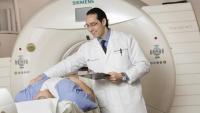Computed Tomography (CT)

Make an Appointment
We have locations throughout Manhattan and Westchester. View all locations and contact info.
Computed tomography (CT) is an X-ray exam that uses specialized equipment to produce cross-sectional pictures of the body. Each cross-section represents a “slice” of the part of the body being imaged. Using special software, three-dimensional images can be made from the individual slices, providing greater clarity and more detail than conventional X-ray images.
Doctors use CT scans of internal organs, bones, soft tissue, and blood vessels to:
- diagnose disease, trauma, or abnormalities
- plan and guide surgical, interventional, or other therapeutic procedures
- monitor the effectiveness of therapy for diseases such as cancer and infection
A CT imaging system includes a scanner shaped like a donut, and a motorized table that slides in and out of the opening in the scanner. You will lie on the table while the scanner collects images from many different angles. These are sent to a computer, which reconstructs all of the individual "snapshots" into one or multiple cross-sectional images (slices) of the internal organs and tissues.
For some CT exams we will give you a contrast agent (dye) intravenously or by mouth to make the organs and structures more visible in the images we create.
How do I prepare for the test?
- Check in for your appointment on the Connect patient portal. You may also check in when you arrive at the imaging center.
- If you are scheduled for a CT scan with contrast, do not eat or drink for three hours before your appointment.
- If you are scheduled for intravenous pyleography (CT IVP), do not eat or drink after midnight the night before your appointment.
- Your physician will advise you about taking medications during the fasting period.
- If your abdomen or pelvis is being scanned, you may need to drink a flavored liquid that allows better visualization of the gastrointestinal tract. You will be asked to come to the office prior to your test to drink one to two bottles of this liquid. You must drink the first one an hour before your procedure, and the second bottle 30 minutes before.
- On the day of the exam wear comfortable clothes, and you may be asked to change into a gown when you arrive at the CT exam site.
What will happen during the test?
A CT exam is usually painless and quick. If your doctor has requested that you have a CT scan with contrast, we will first insert an IV, usually into your arm. You may feel a warm, flushed sensation and may have a mild, unpleasant taste in your mouth for a few minutes.
We will then take you to the CT exam room, and position you on the CT table, usually on your back. When the table slides into the scanner a red light may shine on your body, which helps ensure that you are properly positioned. We use the most up-to-date CT scanners, which make only slight buzzing and clicking sounds as the scanner revolves around you. The CT technologist will leave the room to perform the scan, but they will be able to see, hear, and speak with you at all times.
The technologist will ask you to hold very still and may ask you to hold your breath during the scan. Any type of movement during a CT scan will make the images look blurry and may cause the scan to have to be repeated.
The scan will take between five and 15 minutes to complete.
Are there any risks?
CT exams use higher radiation doses than conventional radiography because the CT image is reconstructed from many individual X-ray projections. If the exam is medically necessary, the risk is quite small compared to the benefit of an accurate diagnosis or intervention. Some people may have an allergic reaction to the intravenous contrast agent, or dye. Severe allergic reactions are uncommmon, and we are well-equipped to deal with them.
After the test
- After the exam you can immediately resume your normal activities.
- If you drank liquid for an abdomenal or pelvic scan, increase the amount of fluids/water you drink for several hours.
- A radiologist will analyze the CT images and communicate the results to your health care provider who requested the exam. Your health care provider will then discuss the results with you.


